Tutorial, presented at the ICDAR'99, Bangalore,
Part (b) of tutorial, presented at the ICDAR'99, Bangalore, Sept. 19.
Pen-based annotation of photographs
Lambert Schomaker
NICI / Nijmegen University
The Netherlands
hwr.nici.kun.nl
Overview
- Others: L. Vuurpijl, E. de Leau, A. Baris, M. Koenen, E. Hoenkamp
- Image-based queries on WWW: existing methods and their problems
- Query types
- A pen-based annotation and query scheme
- Experiments
(b): pen-based image annotation and queries
Acronyms galore
- IBIR - image-based information retrieval
- CBIR - content-based image retrieval
- QBIC - queries based on image content
- PBIR - pen-based image retrieval!
(b): pen-based image annotation and queries
Existing Methods
- QBIC (IBM)
- VisualSEEk (Columbia)
- Four-Eyes (MIT Media)
- Webseek (Columbia)
- Excalibur
- Imagerover
- Chabot
- Piction
- (i.e.,... booming business)
QBIC (IBM)
- Features:
- colors, texture, edges, ... later: shape (bitmap) added
- Matching:
- layout, full-image templates, shape (bitmap, mouse)
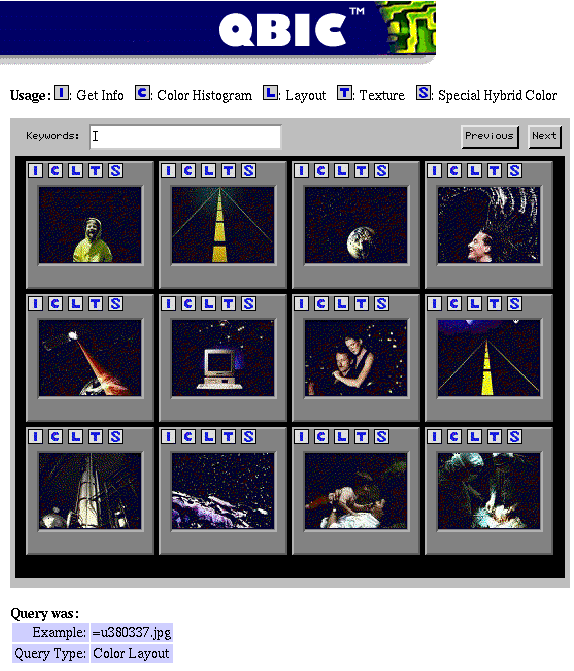
... but what was the user's intention with the query (top left photo = query)?
VisualSEEk
- Features:
- colors, texture, edges, ... later: shape (bitmap) added
- Matching:
- layout, full-image templates, shape (bitmap, mouse)
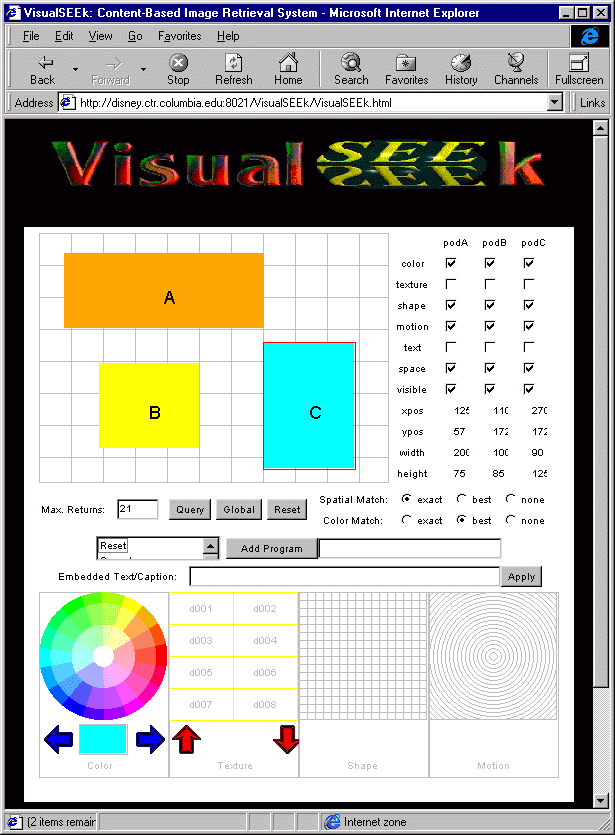
... cumbersome, feature selection/weighing requires knowledge ...
FourEyes (MIT Medialab)
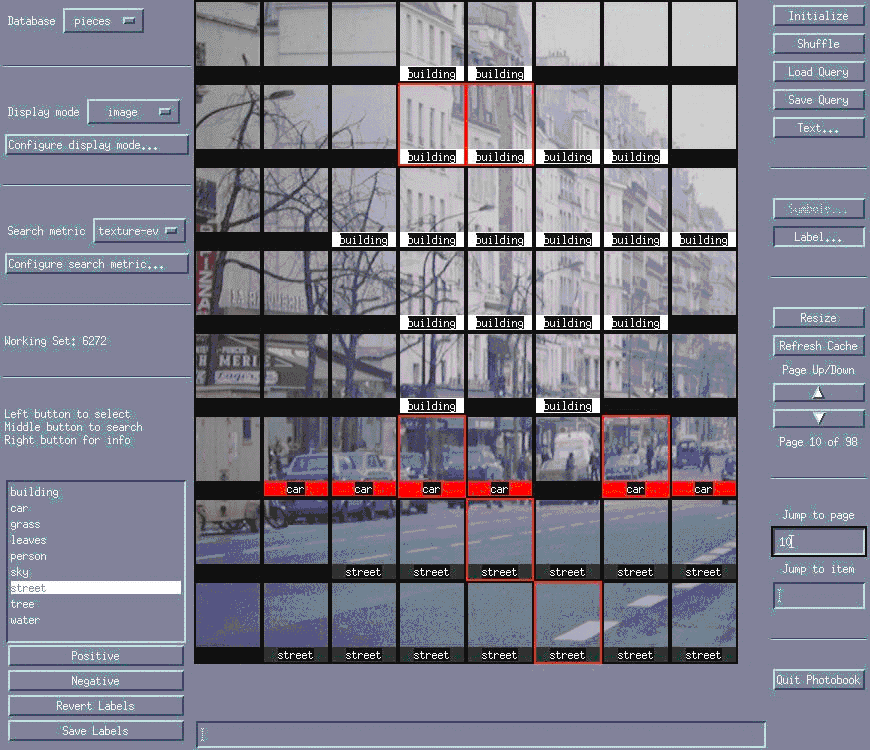
- imposed block segmentation
- textual annotation per block
- labels are propagated on the basis of texture matching
... relation between texture and object-related content unclear,
arbitary segmentation creates ambiguity...
(b): pen-based image annotation and queries
Query types
| |
Query |
Matched with: |
Matching algorithm |
|
|
| A |
keywords |
manually provided textual image annotations |
free text and information-retrieval (IR) methods |
| B |
keywords |
textual and contextual information in the image neighbourhood |
free text and IR methods |
| C |
exemplar image |
image bitmap |
template matching or feature-based |
| D |
rectangular sub image |
image bitmap |
template matching or feature-based |
| E |
layout structure |
image bitmap |
texture and color segmentation |
| F |
object outline |
image bitmap, contours |
feature-based |
| G |
object sketch |
image bitmap |
feature-based |
(excluded from this table are:
point & click navigation in systematically organized image bases)
(b): pen-based image annotation and queries
Problems
- full-image template matching yields bad retrieval results
- feature-based matching requires a lot of input and knowledge by the user
- layout-based only suits a subset of image needs
- reasons behind a retrieved image list are unclear. Features
and matching scheme are not easily explainable to the user (Picard, 1995)
- can the system learn from previous
queries in a user community?
(b): pen-based image annotation and queries
Ergonomic, Cognitive & Perceptual aspects
- computer users are continuously evaluating the value of system responses
as a function of the effort spent on input actions
- a survey on WWW revealed that users are interested in
objects (71%),
and not in layout, texture or abstract features. The preferred image
type is photographs (68%),
N=170 respondents. (Schomaker et al, 1999)
- objects are best recognized from 'canonical views' (Blanz et al., 1999),
(and photographers know and utilize this)
(b): pen-based image annotation and queries
How to realize such object-based image search?
- object recognition in an open domain? Not possible yet.
- manual annotation/textual queries? Possible but expensive.
MPEG-4 and notably MPEG-7 allows for sophisticated annotation.
But who is going to do it: the content provider or the user, and how?
- "what if a form of annotation existed by which intelligent
pattern classification could be bootstrapped, on the basis of
machine learning?"
(b): pen-based image annotation and queries
Design considerations
- focus on object-based representations and queries
- focus on photographic images with identifiable objects for which
a verbal description can be given
- exploit human perceptual abilities in the user
- exploit human fine motor control: use a pen to draw object outlines
- allow for incremental annotation of image material
(to obtain PR bootstrap)
- start with a limited content domain
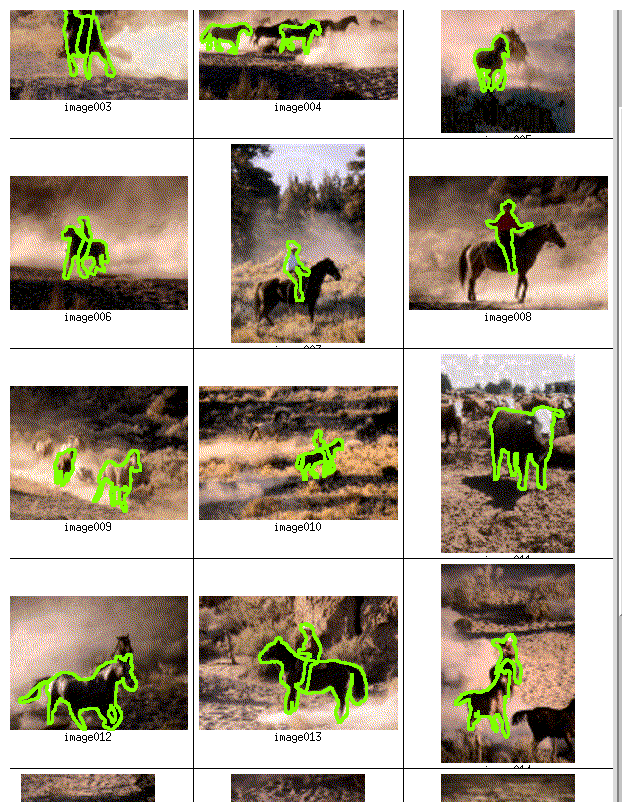
(multiple outlines per photograph are allowed)
(b): pen-based image annotation and queries
Example: animal collection, the outlines
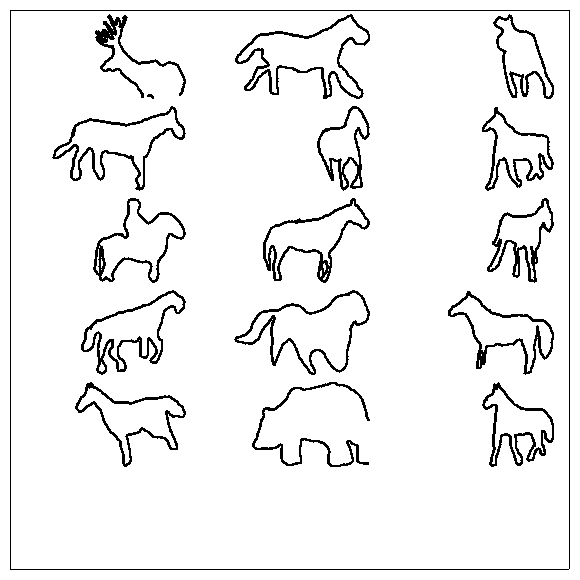
(b): pen-based image annotation and queries
Example: 'bodyworks' shape of motor bicycles
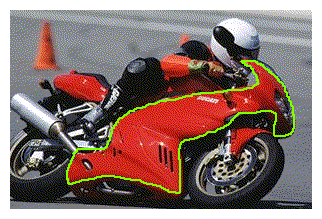
(note the distribution of points of high curvature along the outline)
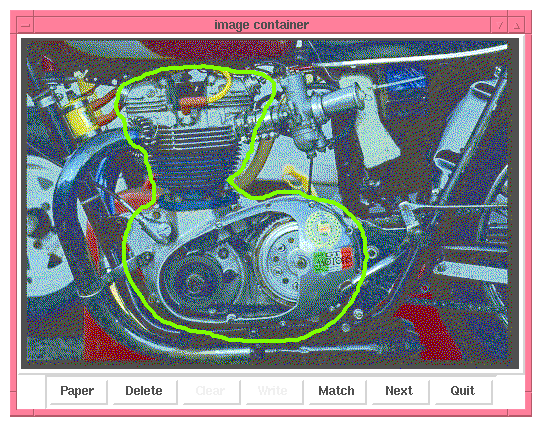
A query to find an engine
(b): pen-based image annotation and queries
Annotation
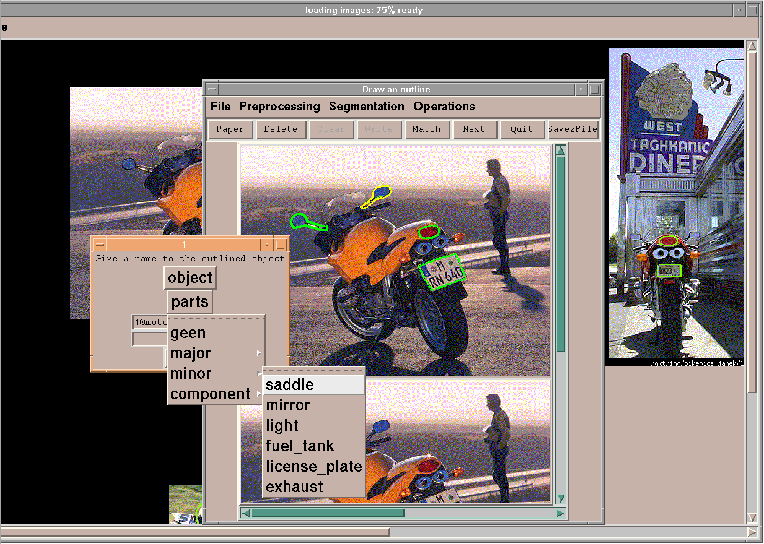
- after producing pen outlines, it is useful to ask the user
for a text label (keyboard,speech,handwritten)
- in human cognitive representation of objects, a distinction can be
made between 'basic categories', and sub-ordinate and super-ordinate
levels (Rosch, 1978). The word "chair" is a mental picture producer,
while the more abstract "furniture" is not. This has consequences
for the textual annotation of images.
(b): pen-based image annotation and queries
Algorithm: a few matching possibilities
- (a) match the query outline ([(x)\vec],[(y)\vec])
with all outlines which are present in the database
- (b) match the image I(x,y) content within the outline
([(x)\vec],[(y)\vec])
with existing templates in the database,
- (c) match a query outline with image edges DI(x,y)
of unseen photographs (!)
Simple 1-NN matching will be used for all feature categories.
Outline matching: best starting point and clockwise/counterclockwise search.
(b): pen-based image annotation and queries
System architecture

- HP-UX and Linux
- C and Tcl/Tk
- outline input: mouse or pen
(b): pen-based image annotation and queries
Performance measurement aspects
- class labels are needed (!?). Total number of instances is N.
Number of instances per class is r.
- a hit list of n images is assumed (e.g., n = 10)
- Performance measures?
- Precision P: the % of images in the retrieved hit list
which belong to the intended class (i.e., relative to n)
- Recall R: the % of intended images in the hit list, relative to
the total number of instances r of that class.
- Criterium for "good Precision"?
(b): pen-based image annotation and queries
Hit list: accident or meaningful?
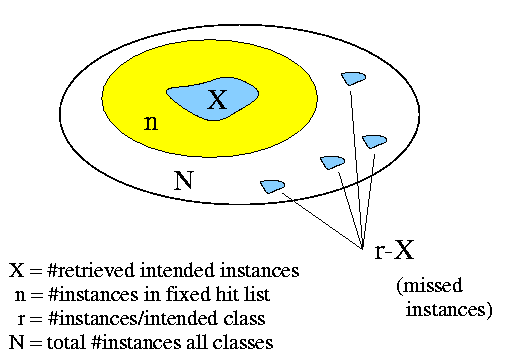
(b): pen-based image annotation and queries
Hit list: accident or meaningful?
Assume a collection of N items where r(ight) of these items are of
one type (type A) and the remaining N-r are of another type (type B).
Wanted is the probability of obtaining exactly X items of type
A in a subset of n elements randomly drawn from the total of N items.
Then X is distributed according to the Hypergeometric Distribution:

Given a precision proportion q for the result of a particular query,
there will be a number of x = n q correct items in the hitlist.
For a meaningful result we want q >> p(X = x).
Example (given N=750 images in total
r=50 instances in target class,
n=16 images in hit list):
P(X=0) = 0.33
P(X=1) = 0.38
P(X=2) = 0.21
i.e., Finding 1 hit in list of 16 is not so unlikely: p = 0.38
(b): pen-based image annotation and queries
Test the concept: Can the users do it?
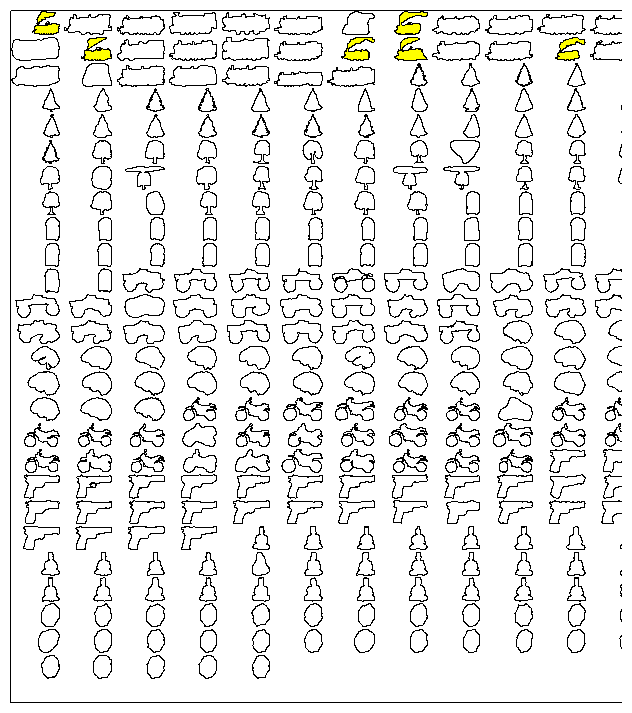
Number of subjects producing an outline: 33, number of photographs: 10.
Photographs: brain, Buddha christmas tree, monster truck,
jukebox,locomotive, motor cycle, mushroom cloud, pistol.
Results kindly provided by Arie Baris.
(b): pen-based image annotation and queries
Test the concept: Can the users do it?
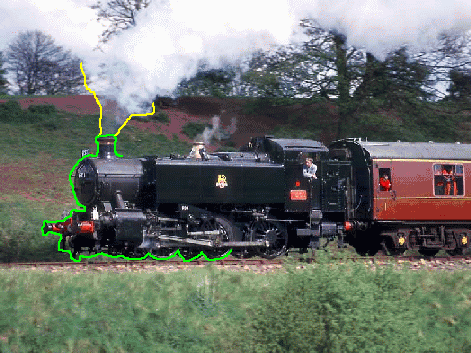
- Answer: yes, but multiple interpretations are sometimes
possible (locomotive with or without smoke)
- Subjects differ in their precision to follow all curvature
peaks
(b): pen-based image annotation and queries
Hierarchical clustering on outlines
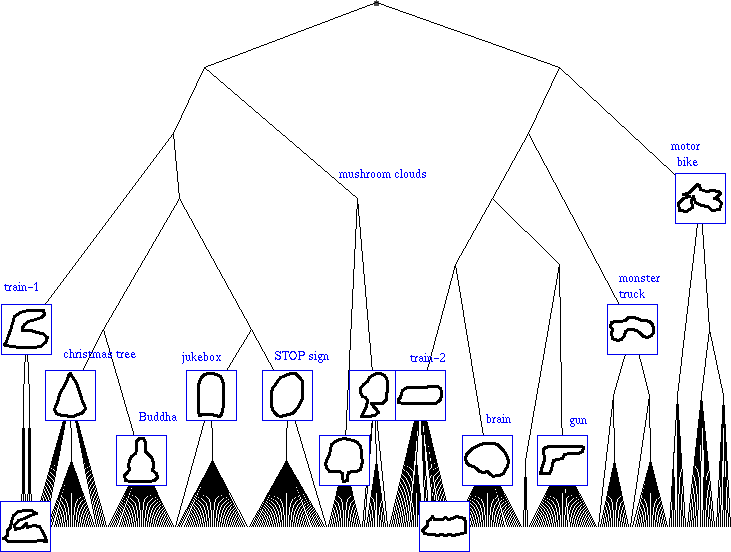
- cluster structure shows separability of shapes
(b): pen-based image annotation and queries
(b) Conclusion
- Users can do it (but it is more 'expensive' than typing keywords)
- Outline matching works well in objects of medium complexity.
- The simpler the shape, the more important becomes pixel content
within the outline
- Catch: for generalizing by use of outline to image-edge matching,
translation, scale, rotation and mirror invariance must be solved!
This is easy in outline-outline matching.
(b): pen-based image annotation and queries
(b) Conclusion (continued)
- Problems of occlusion and perspective play less of a role than
expected
- Multiple-outline matching allows for geometric structure matching
in multiple objects (Del Bimbo, 1998)
- You can do more with a pen than handwriting alone!
References
Blanz, V., Tarr, M.J. & Buelthoff, H.H. (1999).
What object attributes determine canonical views?
Perception. 28, 575-599.
Del Bimbo, A. and Vicario, E. (1998).
Using Weighted Spatial Relationships in Retrieval by Visual Contents
IEEE Workshop on Content-Based Access of Image and Video Database
in conjunction with CVPR '98, Santa Barbara, California, USA, 35-39.
Pentland, A., Picard, R., and Sclaroff, S.,
Photobook: Tools for Content-Based Manipulation of Image Databases
SPIE Storage and Retrieval of Image & Video Databases II, Feb 1994
TR #255
Picard, R.W. (1995)
Light-years from Lena: Video and Image Libraries of the Future
Proceedings of the International Conference on Image Processing
(ICIP), Oct '95, Washington DC, USA. Vol I, 310--313.
Rosch, E. (1978).
Cognition and Categorization. Hillsdale, N.J.: Erlbaum.
Schomaker, L., de Leau, E. & Vuurpijl, L. (1999).
Using pen-based outlines for object-based annotation and
image-based queries. In: D.P. Huijsmans and A.W.M. Smeulders (Eds.).
Visual Information and Information Systems, New York: Springer,
pp. 585-592.
Schomaker, L., Vuurpijl, L. & de Leau, E. (1999).
New use for the pen: outline-based image queries.
Proceedings of the 5th International Conference on Document Analysis
and Recognition (ICDAR '99). Piscataway (NJ): IEEE. pp. 293-296.
Vuurpijl, L. & Schomaker, L. (1997).
Finding structure in diversity: A hierarchical clustering method for
the categorization of allographs in handwriting,
Proceedings of the Fourth International Conference on Document Analysis
and Recognition, Piscataway(NJ): IEEE CS, p. 387-393. ISBN 981-02-3084-2
URLs as of 14-9-1999
http://www.qbic.almaden.ibm.com/
http://www.media.mit.edu/~tpminka/photobook/foureyes/
http://www.ctr.columbia.edu/~jrsmith/VisualSEEk/
Tutorial "new pen-based applications" ICDAR'99 Bangalore. Copyright 1999 L. Schomaker
















